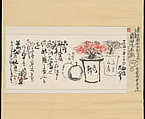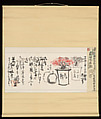“Rubble of writing” (Moji gareki), a letter to Baron Maeda Masana
Tomioka Tessai Japanese
Not on view
In content this is simply a piece of correspondence between two men of modern Japan: Tomioka Tessai, one of the last great painters and calligraphers of the Nanga tradition, and Baron Maeda Masana (1850–1921), an influential agriculture minister and proponent of exporting Japanese culture and merchandise to the West. Yet, Tessai has inscribed it in his distinctive, idiosyncratic hand and added sketch paintings to turn it into a delightful work of art.
As is the case with all such letters, the fame of the individuals adds to the intrinsic interest. Tessai is well known to all students of Japanese art, but Maeda is less well known. Maeda was a scion of a prominent samurai family of the Kagoshima clan, and a doctor of herbal medicine. He became member of the House of Peers and held court rank as a danshaku (baron). A noted linguist he helped compile Wayaku Eijiten (English-Japanese Dictionary) and Satsuma Jisho (Satsuma Dictionary).
Yet most interesting for Western audiences is his role in introducing Western culture to Japan and Japanese culture to the West. He first traveled to France for study in 1869 and worked as a clerk in the French Legation. While there he directly experienced the excitement of Japonisme that was gripping Europe. After returning to Japan, he served as the director of the Paris International Exposition in 1878, at the young age of 27. Maeda was the official advocating that Japanese manufacturers focus on producing three standard of goods for expositions: elaborate and aesthetic articles reflecting the highest standards of traditional Japanese craftsmanship; items suitable for practical use in the West; and low-priced goods finished to a high standard. Thus from a purely entrepreneurial point of view, Maeda helped establish the image of Japan in the West. The Japanese Exposition Bureau published a booklet in French, entitled “Japan in the 1878 World Exposition” to explain Japanese ceramics and other exhibits, along with explanations of the country’s politics and culture. Maeda also published essays on Japanese arts and crafts in a variety of European popular magazines, and through this media strategy broadened understanding and interest in Japan.
In 1888 he served as the governor of Yamanashi Prefecture. He went on to serve as director-general of the Industrial Affairs Bureau of the Ministry of Agriculture and Commerce in 1889, and as the Vice-Minister of Agriculture and Commerce in 1890. He became famous for traveling across Japan to help promote an agrarian movement, and was called “Agriculture Minister for the people.”
This image cannot be enlarged, viewed at full screen, or downloaded.
This artwork is meant to be viewed from right to left. Scroll left to view more.



